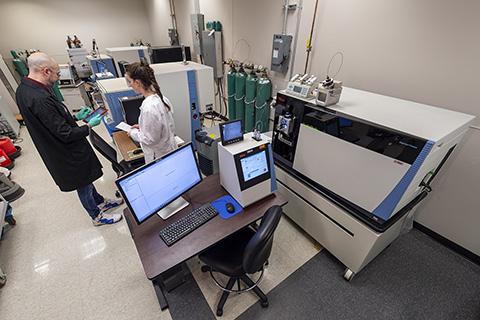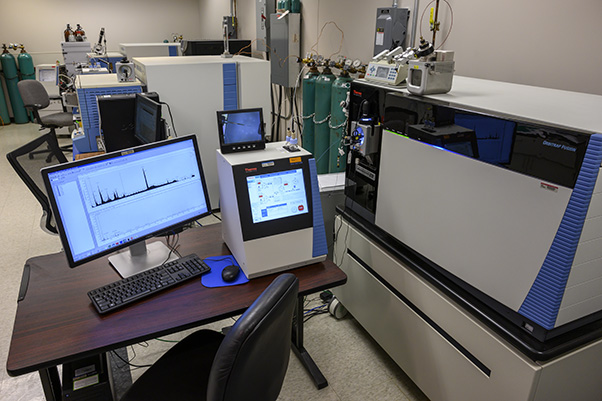Editor’s note: This article is part of a series about scientific devices in use at NCI at Frederick and the Frederick National Laboratory. Other parts of the series can be found here. Mention of trade names, commercial products, or organizations does not imply endorsement by the U.S. government. Ben Orsburn no longer works at the Protein Characterization Laboratory Mass Spectrometry Center.
Ben Orsburn, Ph.D., stood in the middle of a 180-square-foot laboratory, speaking over the white noise that flooded the room. The source of the din—large, desk-sized objects called mass spectrometers—filled nearby rows of lab benches. Orsburn pointed to one along the periphery of the room, a white-and-black box with the words “Orbitrap Fusion” emblazoned on the front in small blue text.
“I can characterize every detectable protein in a cell on any instrument in this room. The only one I can do it [on] in a weekend is this one,” he said with a grin.
The Fusion is one of many cutting-edge instruments that scientists in Frederick use to conduct their complex research. It’s a million-dollar device that combines three mass spectrometry methods, which, according to manufacturer Thermo Fisher Scientific, provides a nearly unmatched level of speed and efficiency.
Mass spectrometers contain diminutive vacuum chambers—each one in the Fusion is small enough to fit inside your mouth—and electromagnets and sensors that measure the mass of molecules. Orsburn and his colleagues in the Protein Characterization Laboratory Mass Spectrometry Center use their Fusion to help Center for Cancer Research scientists figure out which proteins exist in cells related to various diseases.
The proteins have a tumultuous experience. After being chemically cut apart and suspended in a liquid solution, they’re slowly pumped into the Fusion and zapped with a high-voltage charge that instantly vaporizes them into ionized gas. The gas is fed into the vacuum chamber, where the electromagnets emit magnetic fields to move the gas around at dizzying speeds—unofficially estimated at 30 kilometers per second (approximately 67,108 miles per hour). A device known as the quadrupole mass filter collects mass-to-charge measurements, while another, the Orbitrap, collects promising samples for further analysis.
In a second chamber, the samples undergo collision-induced dissociation—vibrational waves blast them into molecular smithereens. The Fusion scans the fragments, then measures their mass by catapulting them out of the chamber one-by-one. Afterward, Orsburn compares the measurements with a complete list of proteins that could potentially exist in the cell. He gives the data to Center for Cancer Research scientists, who use it to learn more about diseases or to develop better drugs.
The Fusion measures an average of 2,000 proteins per hour, which Orsburn says is much faster and more efficient than its predecessors. An older model, the Orbi XL, sits just across the room from the Fusion. It uses four times more electricity; measures at one-tenth of the Fusion’s resolution; and is, on average, four times slower.
Soon after the Fusion was released in 2013, scientists at the University of Wisconsin demonstrated that it could analyze every type of protein in a yeast cell—4,000 different proteins—in just 80 minutes. Much of the Fusion’s analytical speed depends on its Orbitrap, a device developed in the 1990s and deployed in mass spectrometers in the early 2000s. The Orbitrap uses a mass spectrometry method known as Fourier transform ion cyclotron resonance to examine the molecular masses simultaneously—a major improvement over previous devices that used a slower, sequential method. Orbitrap and linear ion trap technology have been progressively refined since their inception, resulting in the Fusion’s “tribrid” (tri-fold hybrid) capability.
The Fusion packs enough power that Orsburn and his colleagues could fully analyze the much larger repertoire of proteins in the human body in only two days. Although every study doesn’t require that level of detail, the Fusion’s speed helps the Mass Spectrometry Center’s Center for Cancer Research partners get their data sooner.
“That’s where the technology is really just explosive,” Orsburn said.



